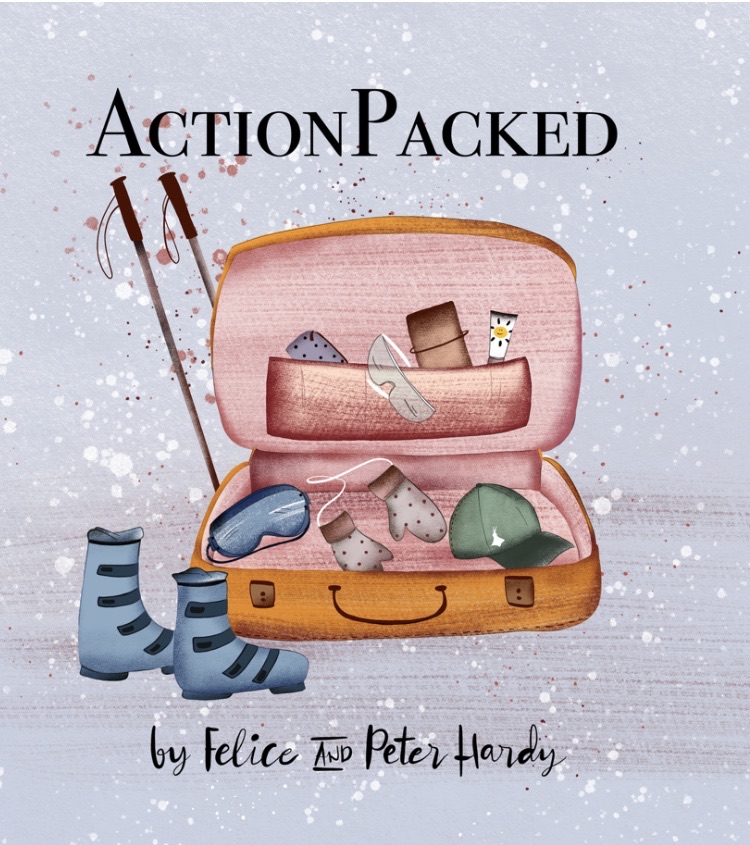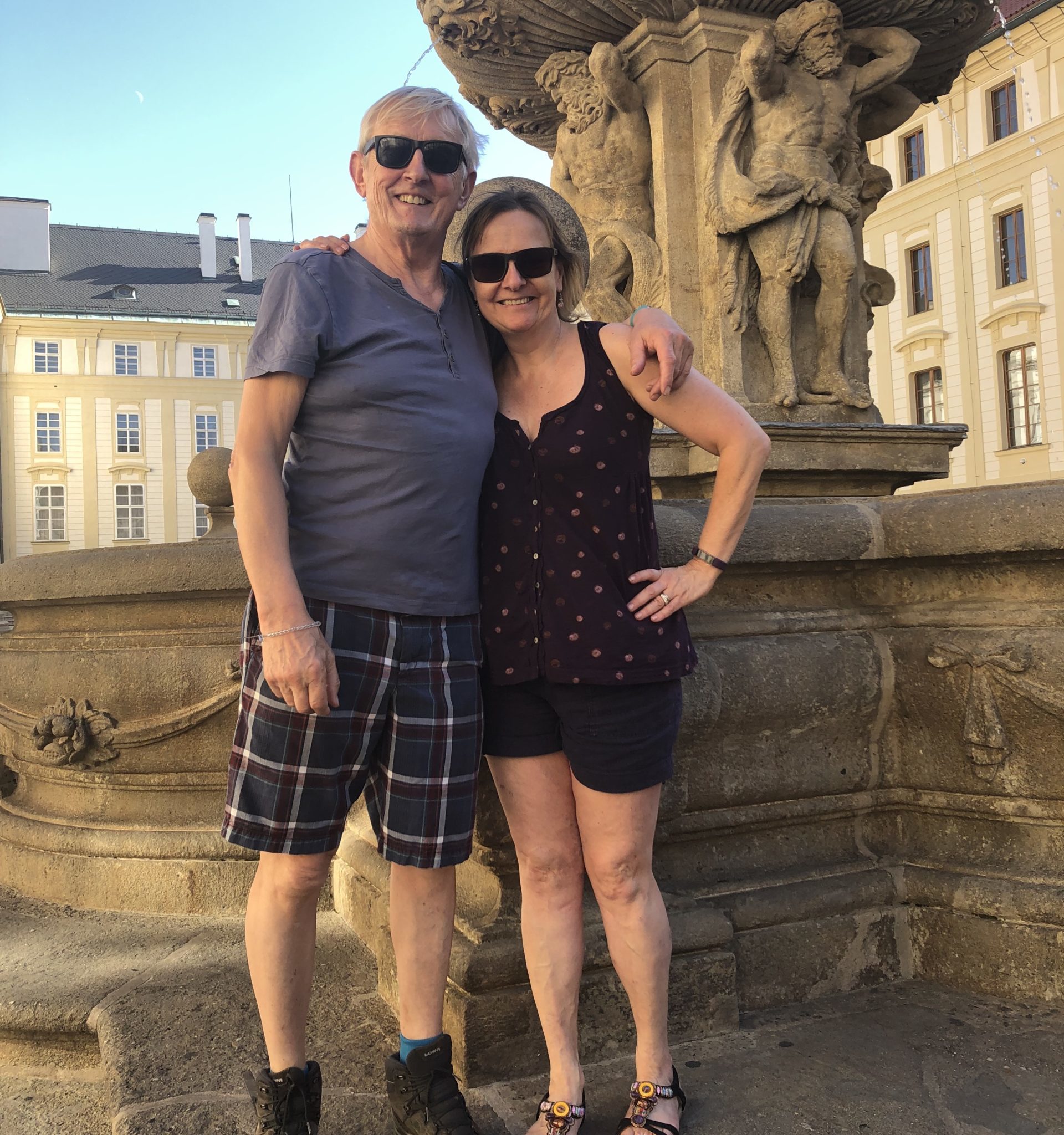
Louise flying
‘For a few seconds, you don’t know whether you’re upside down or inside out, and suddenly you realise that it’s rather fun, you’ve got a minute of this freefall.’
‘The action really is quite periphery – I’m driven by people stories, I’m driven to find out more about the people behind the places.’
****************
Peter Welcome to our travel podcast. We’re specialist travel writers and we’ve spent half a lifetime exploring every corner of the world.
Felice We want to share with you some of our extraordinary experiences and the amazing people we’ve met along the way. So Louise Hall, listeners will have heard you on three interviews with Action Packed Travel, but we thought now is the time to find out a bit more about you.
Peter You’re a bit of an action girl yourself, aren’t you? You’ve done all sorts of things with your life, and what was interesting us was what you did last week.
Louise Yes, last week I jumped out of a plane for the first time ever. Terrifying.
Peter I presume you had a parachute on?
Louise Yes, it was a tandem skydive. So I had a parachute and a backup, but most importantly, I had an instructor who knew what he was doing.
Peter You were tied to him?
Louise Yes, I was tied to him. So it was the result of a dare from friends. I hate heights. So it was a belated 40th post-lockdown and I got a group together and we went down to GoSkyDive, which is two hours west of London in a place called Salisbury, which is incredibly beautiful above Salisbury Plain at Old Sarum Airport. We went there, we had a safety briefing, we were strapped into a metal harness a bit like a giant adult baby bouncer, and we were taught what to do. Basically the most important thing is just really lift your legs because the instructors do everything else. You have to really lift your legs up because coming in to land, if you catch your feet, that can really cause great damage at the speed and weight of the two of you.
Peter I can well imagine. So going back to the beginning here, most people, if they go parachuting…go skydiving, they do some straight-line parachute jumps first of all, but you go straight into the deep end.

Louise, right, with her group of friends. Photo: © LH
Louise I would say thrown in at the deep end. It was my first jump – from the highest you can jump, which is 15,000 feet with one minute of freefall. But I managed to rope in a whole lot of other friends to also try it for the first time. There were six of us.
Felice If you’re on your own, could you go and do it and join other people, or do you have to bring your own group along?
Louise Absolutely. If you’re on your own, you can sign up and do it. They take a plane up and within that plane there’s approximately about ten people with a guide – with an instructor, not a guide. Some people choose to get a photographer, which means an extra person jumping alongside. But you can go on your own or you can go as a group. And if you’re going as a group, we booked the first flight in the morning – 8.30am – so we didn’t get split up for weather reasons or whatever.
Peter When I did it…I haven’t done skydiving, goodness me no, but when I first jumped out of a plane it was on a fixed line and it was a bit like something out of World War II this old plane circling somewhere over Oxfordshire. There was a red light and a green light by the door. I’m pretty colour-blind, so that didn’t really help me an awful lot but I guessed it was the lower of the two lights. The sergeant in charge of the whole thing threw open the door and then came the moment and the people in front of me jumped. If you hesitated, he kicked you in the bum and out you went. I hesitated, he kicked me in the bum and out I went. Then I felt this enormous, terrifying sort of rush of air and wondered what would happen next. What was your experience?

Hanging over the edge of the plane
Louise Not that dissimilar, I’d say. No, they are very slick operation. I’d done my research before and it’s a place called GoSkyDive. They’re billed as the UK’s number one tandem skydiving centre and one of the biggest in Europe. I think on a good day they only take about 170 people, so it really is a slick operation. That was reassuring, but I was absolutely terrified. As I say, I hate heights but I like to challenge myself. Even thinking about it, I was giggling nervously for days beforehand – right up to the point of getting on the plane.
Once you’re strapped in – fortunately, there were several jumpers going from 10,000 feet so they opened the door and out they went, shuffled out on their bums. They’re not pushed out these days, you kind of shuffle out, your instructor takes you out. I was at the front, so I was sitting there watching them and just going: ‘Hahaha,’ giggling very nervously.
Then a few minutes later, it was my turn and my instructor shuffled to the front and left me hanging over the edge of the plane. You hang for a couple of seconds until you’re given the green light, the nod, thumbs up. Then you go. It’s exactly that. It’s terrifying, it’s exhilarating, it’s total lack of control and not knowing what’s going on and a kind of G-Force. You’re going 120 miles an hour and it’s terminal velocity…they billed it: ‘You will be going terminal velocity.’ For a few seconds, you don’t know whether you’re upside down or inside out and suddenly you realise that it’s rather fun. You’ve got a minute of this freefall then the parachute kicks in and suddenly everything slows down and you can see where you are and you can see the views out to the south coast and the sea and the rolling, bucolic hills, and it’s rather nice….suddenly, after a terrifying minute.
Felice Did you have total trust in the instructor?
Louise Yes, I did. My instructor had done 25,000 jumps, which is about the most that any instructor will do, even a Gordon Blanard who set up the centre. It’s this South African larger-than-life, incredibly safety-conscious chap who first skydived when he was working as a mechanical engineer in Namibia on the Skeleton Coast back in 1992, after a bar dare. So I was really reassured to be with an instructor who had 25,000 hours.
Peter That’s certainly a lot of hours.
Louise Yes. And I trusted him implicitly more than myself after five hours of training or whatever it would be, so all good.
Peter What about coming inland to land? What happens then? You can talk to each other at this stage?
Louise Yes, you can a little bit actually. We had masks on, so my mask kept blowing up over my eyes; I was trying to pull it down. So, yes, the key thing to remember is lifting your legs up, really lifting them up because you don’t want them to catch, because with the weight of two people and a heavy instructor coming in at that speed, you can really cause damage. And that’s pretty much the only damage. I mean, I think when I asked him if they’d had anything go wrong, he said, ‘Well, yes, a woman really hurt her ankle,’ but nothing more. So that’s the key thing to remember.
Peter Do you land on your feet?
Louise I was worried about the landing, but it was so smooth. You come in and we just kind of glided over the grass. I mean, it’s just so smooth and then all quiet and then watched the next jump. As I landed first I watched all the next jumpers landing, which was rather fun.
Peter Will you do it again?
Louise Yes, I would.
Peter Is it quite expensive to do?
Louise It does add up. I think it’s a really good family experience. Bearing in mind we can’t travel at the moment, it was lockdown, you can do these things right on our own doorstep and it does feel like you’ve been away. It feels like you’ve been fully away; you come back a completely different person at the end of the day. The cost is between £200 and £300 and then you have some add-ons.
Felice So you could then go and do it anywhere else in the world next time, couldn’t you? You don’t have to do it in the same place?
Louise No, exactly. I mean, I have no qualifications at all. So I would jump as a beginner, but absolutely. Actually, Gordon said that since setting up the centre, he’s made it his mission to jump all around the world and see how people are trained. I think that’s one of the joys, because it’s actually the experience of seeing where you are at from a different perspective, from a bird in the sky, and seeing those great vast expansive horizons above the clouds and coming through the clouds. So, yes, I would say be brave and give it a go.
My godmother was actually a huge inspiration for the skydiving because she did a jump in her late 60s, early 70s. She’s a mother of four, a grandmother of 16 now, and if she can do it, surely I can too…I’ll give it a go.
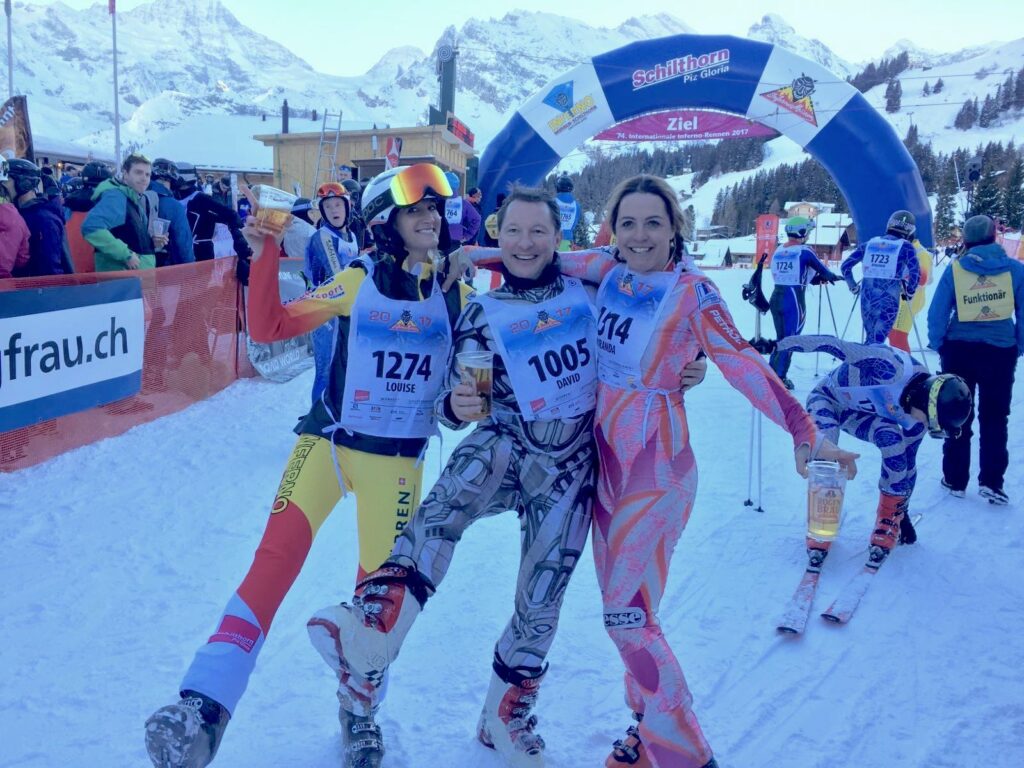
Louise, left, after completing the Inferno in Mürren, Switzerland. Photo: © LH
Felice Skydiving isn’t your only dangerous activity. We actually met you for the first time on a plane coming back from Geneva.
Peter I have to say, none of us jumped out of it.
Felice Thank goodness. But you’d been skiing, I think?
Louise Yes, I think we’d all been skiing. And I have to say it was a real joy to meet you and it was quite by chance. My original flight had ben cancelled and I kind of shuffled onto another flight. We sat next to you both and I’ve heard so much about you. I’d just climbed and skied Mont Blanc for a ski feature.
Peter That’s pretty serious. I mean, not many people get to do that. I know it’s more of a walk-up than a climb-up, isn’t it?
Louise It is normally. This was in April so it was a ski up; we needed crampons, we were on skis with skins. We overnighted in the huts. We had to climatize by climbing the Gran Paradiso, which was another 4000-plus metre mountain before. But the conditions were icy; you leave at 2.30am in the morning, we had torches and it was pretty hairy at certain points, and Italians in front of us, who kind of settled into this chain of head torches – like snails going along a silvery trail up the mountain and they slipped. One of the guys slipped, lost his skins and almost took out the whole lot.
I think it was about ten people caught up in this chain of ropes and it was right above a serious crevasse where they’d said: ‘Do not fall, do not do anything wrong,’ which of course is when people lean into the mountain and slip because you have to do the opposite – you have to lean out to get a grip. The natural feeling is to want to hike the mountain and then people on skins fall. Actually, we were so lucky we could just step aside and get out of the trail that we were caught up in and then carried on up. Then at the end, you take off your skis, you need ice axes, and so it was really snowy. Then when we got there, about 10am as the sun rose, looking over Europe, really sensational, we actually skied the north face route in the tracks of the original assenters.
Peter That’s pretty serious, isn’t it? A serious descent.
Louise It was pretty special. Coming back down off the mountain you have to be very careful and I did request to be roped up at one point because I’ve got a son and I don’t want anything to happen. But I have to say that when we were in the hut, there was a couple of older guys who weren’t leaving until late and when we got back to Chamonix, there was a storm, a big electrical lightning storm – that’s the strange thing out there. The cloud above Mont Blanc is called ‘the donkey.’ They say that the weather can change in a nanosecond…or within a couple of hours, and it does. We later heard reports that two people hadn’t made it down that day. That’s how serious it is.
Felice You mentioned a minute ago about your son and I don’t know about you, but when I had children everything changed in terms of adrenaline activities and dangerous things. Instead of just having myself to think about, suddenly I had to think about my children and what would happen if I injured myself badly or killed myself. I’ve heard other people – women – say this as well…other women who have children, that everything suddenly changes in terms of what you’re prepared to do. Has that affected you at all?

Tordrillo Mountain Lodge in Alaska. Ice hole is visible behind the ski plane. Photo: © LH
Louise It has, it really has. It doesn’t sound like it has from my various adventures, but after Mont Blanc, that was that was it. But actually, it was my husband after our son was born, insisting I go heli-skiing to Alaska in 2008 that really pushed my envelope and it terrified me, but it also showed me that I could get fit and strong again and as long as I was within my comfort zone, I could do these things. Mont Blanc was a little bit more out there, but really it’s just not wanting to put myself in situations where there’s any significant danger of death.
Peter You say that, but you skied in Alaska, which is some of the most extreme skiing in the world. I should just explain that heli-skiing, for these who don’t know about heli-skiing, is nothing to do with James Bond jumping out of helicopters. A helicopter actually lands and you get out of the helicopter and then you ski down with a guide. It’s simply acting as a lift in places where there’s no lift system. I think heli-skiing in Alaska you did something pretty strange there, what was that?
Louise Yes, well, I have to say that my kind of extreme skiing goes right back to my young 20s, so it predates kids. We had a pretty extreme experience out there in a helicopter. So you actually take off from the lodge in a Beaver plane – a post plane – and to push out to ski uncharted terrain they take you by plane because it’s all about fuel conservation, drop you, and then the helicopter came and picked us up and dropped us at the top of this range where we have been skiing the couloirs. They look terrifying from the images but actually, when you’re on them it’s just taking it turn by turn, not rushing it. We were dropped on this couloir where the helicopter didn’t even land; there wasn’t enough space. So it hovers and it hovered terrifyingly close to this wall of rock because the one thing you don’t want is the blades to catch – that’s the key safety issue.
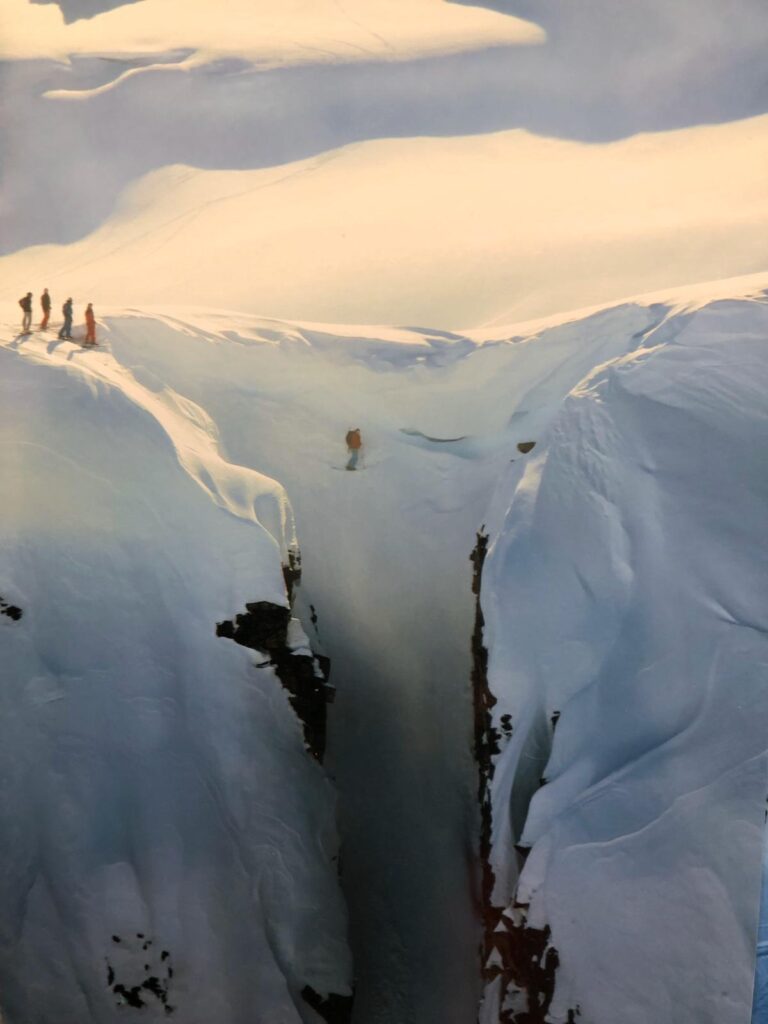
The Manhattan, next door couloir to Line of the Year. Photo: © LH
Peter So the helicopter can’t land, so how do you actually get out of the helicopter?
Louise Good question. We climbed down onto the skis of the helicopter – because it has skis and not wheels – and then a foot down and we were told to just sit there and hunker in the really soft snow, buried in snow like huskies, and then the guide takes out the skis from the ski locker and the helicopter just slightly nose down and flies off and kicks up this the spray. We were left sitting there looking at each other, giggling, because again the only way down is with our skis on; heading down – that’s the only way out of there. There are these two great walls of rock and the couloir and the guide went first, then another friend, Piers, went next.
Then I went and actually, once you are in it, it was surprisingly soft. You just take it carefully, turn by turn, and at the end of the line it opens up. That’s a really fun bit: this big mountain bowl of white and you ski down quite fast and back down to the helicopter. But next to it is this couloir which is terrifying, and this extreme skier called Cody Townsend – incredibly talented man – was awarded the Red Bull extreme skier, I think it was called Line of the Year 2014 in the movie he did, Days of Youth, and it really is worth seeing. I mean, the clip is something else – he skied it straight down, at terminal velocity. But it shows you the landscape out there and Alaska is stunning; it is particularly cold, which holds the snow so it’s much safer than other places to to ski or heli-ski or extreme ski.
Peter Then I think you went swimming the same day, is that right?
Louise Yes, correct. We came back and the night before in the lodge, there were 20 or 30 of us there. I’d sat next to Laird Hamilton, this incredible man who’s married to an Olympian basketball player and they live in Hawaii. He was the godfather of big wave surfing and I think he might have even created kite-surfing. He is really into the Wim Hof Method of ice-swimming, so he challenged me and our group to come out and see how long we could last in the lake outside the lodge. This is something that people do: you jump in, jump out within a matter of seconds, but it was amazing. We could actually, day on day, advance it to about 90 seconds. Mind over matter.
It’s basically a hole cut in the ice about 40 metres from the lodge and you wear your flip-flops and you run over and you go down a couple of steps and you hold onto a wooden bar – it can’t be metal because you might not be extracted from it – and you lie in the lake up to your nose. Afterwards you jump out and there’s a hot tub and a sauna, and literally by the time you’ve got there your eyebrows are already frozen, your eyelashes are frozen, your hair has frozen. By the time you get to the Jacuzzi, everything starts popping as it defrosts, and you get this incredible rush. I mean, it is so good for you. Apparently, it burns deep brown fat; it really reinvigorates your circulation and you feel so alert for the next hour or two. You must drink lots of water and then you crash and want to go to bed.
Felice I’m assuming you wear a wetsuit when you do this?
Louise No, a bikini. Speak to Laird Hamilton, he’s extreme.
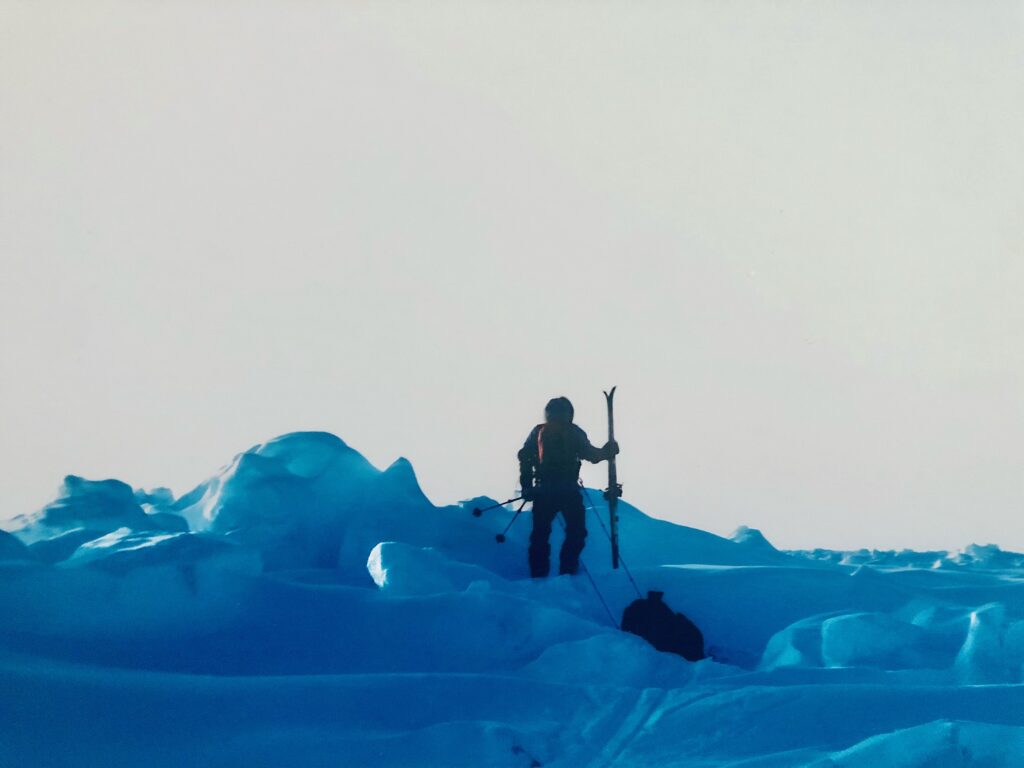
Walking the North Pole. Photo: © LH
Peter You’ve also walked to the North Pole, that’s another of your many activities?
Louise Yes, I like challenges, don’t I?
Peter You obviously like the cold?
Louise Funnily enough, I really don’t get on very well with the cold, which is another challenge in itself. I’d really rather be lying on a hot beach, but I love the beauty and also the history of these places. It dates back to when I was about seven and I was at school and we saw a slide show on Shackleton and I was hypnotised by these images of white and this sense of adventure and going out and endurance, and endurance being trapped in the ice…and I wondered where the women were. So for me, that was a huge motivation because we have the gift to go to these places and if you’ve got a can-do attitude and work will send you…then why not do it?
You know, and when I discovered that the North Pole in 20 years, we wouldn’t be able to ski there anymore, our kids would be swimming – I really felt we need to show the climate change. I was selected for a World First. It didn’t go ahead, but we were really well trained and we were then selected for the expedition that became the Walking With the Wounded recce, the 2011 HRH Prince Harry’s recce expedition up to the North Pole. You fly into Svalbard and you head to Barneo base camp and set off from that.
When we landed in Barneo base camp just before setting off, I went into the mess tent to get a cup of tea and while everyone was putting out all their last pieces of kit, who was sitting there but David Attenborough and he came over to say hello. He sat down on my table and he said, ‘What’s a young woman like you doing up here?’

Louise with David Attenborough at North Pole Base camp. Photo: © LH
Peter It’s a very good chat-up line.
Louise It wasn’t that. I was fascinated to hear why he was there, and of course they were filming Frozen Planet and he was very funny and charming. He said: ‘Well, the thing is, they won’t leave my side because my insurance is so high. They’re worried that I’m going to slip and break a bone or something, so I managed to find a few minutes on my own in the mess tent.’ It was a real joy, and then of course my team came in and they bombarded him and said: ‘Can we have photos?’ So it was a really, really precious moment.
Peter Moving away from cold to warm, you’ve done a lot of diving and you’re a very experienced diver. How did that come about?
Louise The diving came about when I was at university and on the union board it mentioned a summer scholarship with coral cay conservation. I was wondering what to do with my summer holiday, alongside working and there was this offer to do six weeks in the Philippines on an uninhabited island and it said you didn’t need diving experience. I had practise dived and this really was a leap of faith, and I ended up finding myself on a plane and a 24-hour bus ride with chickens to this remote island. When we got there, they trained us up. We were with these Oxbridge marine biologists and we did the PADI basic and the PADI advanced, which is the diving qualifications recognised around the world so that you can dive when you get to a resort. We had to learn about the coral, the reef and the algae, and we learnt a huge amount about the ecology out there.
Basically we were there to map the island. It was under David Bellamy, another really inspiring man, and we then would send the results back to London who would map them on a computer. He presented them to the Philippine government because the local fishermen were dynamiting the reef, killing the coral, and we were seeing these great gravelands of dead coral and no fish, and the local communities were dying and starving.

Diving in Sivota, Greece. Photo: © LH
Every Saturday night we would go and get a boat, a little skiff, over to the village and a little mud hut and do an old karaoke machine with the local villagers, and we could see they were struggling. They were really talking about how God is not being kind to them and the fish are dying and they’re really worried. So actually, the work there was vital, it was to to be presented to the government to change the attitude to dynamite fishing and to preserve their reefs.
Peter So tell us about the diving. You now have the top level of PADI, is that right?
Louise Yes. So another summer at university I worked for a tour operator based out of Corsica, working on the waterfront, ended up being the speed boat driver, teaching water skiing. Whilst there, I managed to get lots of dives with the dive instructor and through that I became a PADI rescue diver. It is always very important for me to know that I can look after others and I will know what to do if something goes wrong…so for me to do that was really important.
Since then, yes, I have dived a few places around the world. We lived and worked in Singapore and dived in Malaysia where there was a huge whale that came in on the night dive. This great wush came past us and later we discovered there was a seven-metre whale in the bay. So, yes…and then Shark Alley in Australia where my brother lives.

Under the ocean off Belize. Photo: © Wouter Naert/Unsplash
Peter You also dived the Blue Hole in Belize?
Louise Yes, that’s right. My last summer holiday at university and I was working for six weeks in London, took two weeks off, went with some mates, and we went to Belize specifically to dive the Blue Hole and for me, that was a real dream. It was a very special experience. When you’re there, you can actually do somersaults and you lose sense of: ‘Where’s up and where’s down, where’s the surface of the water?’ The colours are sensational.
Peter What is the Blue Hole? Is it very deep?
Louise The Great Blue Hole is a marine sink hole off the coast of Belize; it lies near the centre of Lighthouse Reef and it’s a huge cavern.
Felice You’ve never felt claustrophobia, obviously?
Louise I have, and actually whilst out there we do a day trip, cave diving, I still have nightmares about that; it was terrifying. There’s a rope through the caves, but essentially you can’t come up for air if you panic – you have to really be controlled. And you saw great stalagmites and stalactites, stalactites are the ones that come down like tights on your legs – from the caves. But that at that I found terrifying. So yes, I always get scared. I was very scared skiing Mont Blanc, but it’s about overcoming those fears and having a can-do attitude.
Peter I once went patrolling in the Peak District, I have to say, never again, I thought that was a truly terrifying experience because you’ve got to dive down and go through a little tunnel, which if you could see where you were going was absolutely nothing. You can’t see anything and you’ve got to push on through, because if you don’t push on through you you can’t breathe. You’ve got to wait to get through the other side. Not an experience I enjoyed overall; I think I’m a bit too claustrophobic for that.
Louise I think with all these things, you gradually do something new and you’re terrified, and you do a little bit more. Maybe I quite like that feeling.
Peter Louise, what’s driving force behind this Action Girl bit?
Louise The action really is quite periphery. I’m driven to find what’s behind people’s stories; I’m driven to find out more about the people behind the places, the culture behind the places.
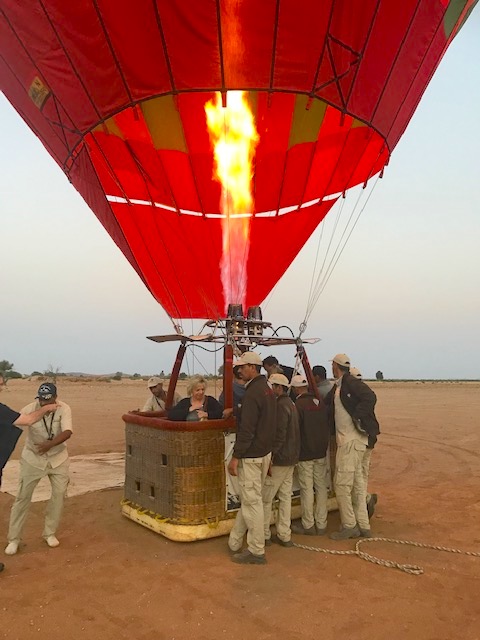
Getting ready to fly over the Sahara and Atlas Mountains. Photo: © LH
Peter Then you’ve done something much calmer – hot-air ballooning in the Atlas Mountains?
Louise Have you tried that, Peter, Felice?
Felice Not in the Atlas Mountains. I’ve done it over the Maasai Mara and quite a few different places, but not Morocco.
Louise That must have been very special. Actually that was the joy of it, was to get a different perspective again from the air and be above the desert and see the Atlas Mountains. You go at sunrise, so you saw the whole land come alive with the berbers and the goats and the cockerels baying and the light…the light quality of seeing the red fortress city starting to glow red in the sunrise. It’s a great thing to do with kids. That was pretty special. You also escape the heat of the day.
Felice Fast forward 20 or 30 years…what would you like to be remembered for?
Louise I suppose the motto I’ve always had in my mind is the old school motto, Arduus Ad Solem – strive towards the sun, but really it would be wanting to give something back. For me, a lot of my expenses come through my journalism and it’s actually not about my experiences – it’s telling other people. I would love to set up an education fund and give something back through Africa and charities, but that’s a long way down the line.
Peter What’s your ideal day? How would you spend it anywhere in the world? One ideal day…
Louise With my family, a book and the beach…or in front of a fire in the mountains.
Felice If you could choose anywhere to live, where would that be?
Louise Salcombe, I would say Salcombe. It’s my favourite place in the world… a coastal kind of riviera town in Devon, west England. We grew up there and that’s where I’d like my ashes scattered.
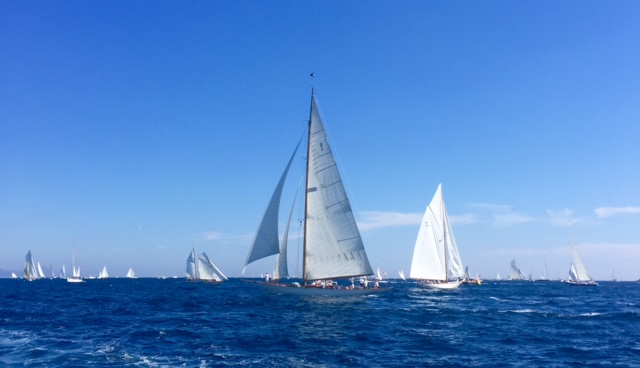
Racing Manitou (J Class), Les Voiles de St Tropez. Photo: © LH
Felice What’s the one thing you wished you’d done sooner in your life?
Louise Probably sailing. I’d have liked to learn my sailing qualifications so I could feel safe on a boat – I feel a bit terrified on a boat out at sea. One thing I hold onto, my Holy Grail, is a quote from the Dalai Lama: ‘Once a year go someplace you’ve never been before.’ The world is pretty magic place, and to get out there and explore it while we can.
Peter It’s been great chatting to you on the show today and we’re really looking forward to you hosting a lot more episodes of Action Packed Travel around the world.
Felice That’s all for now. If you’ve enjoyed the show, please share this episode with at least one other person! Do also subscribe on Spotify, i-Tunes or any of the many podcast providers – where you can give us a rating. You can subscribe on Spotify, Apple Podcasts or any of the many podcast platforms. You can also find us on Twitter, Facebook and Instagram. We’d love you to sign up for our regular emails to [email protected]
© ActionPacked Travel
For other action women, see (or listen) to our episodes on A Solo Hiking Adventure, Matilda Temperley: Action Woman Behind the Lens, and Saving Elephants and Climbing Everest.
![]()
- Join over a hundred thousand podcasters already using Buzzsprout to get their message out to the world.
- Following the link lets Buzzsprout know we sent you, gets you a $20 Amazon gift card if you sign up for a paid plan, and helps support our show.
